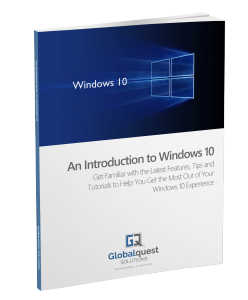Windows 10 is the wish that Windows 8 users had during the time that Windows 7 was still king. Does that make sense? Microsoft finally got it right, and if you can get past the negative press about the inbred keylogger (you can turn that off here), you finally have an upgrade that you can depend on. Here are the basics of learning Windows 10 if you are a Windows 7 or Windows 8 user.
 Centerpoint IT has released our guide to Windows 10
Centerpoint IT has released our guide to Windows 10Download Here.
Learn the Layout.
Windows 10 brings the best of the Windows 8 layout into the future without repeating any of the mistakes that turned off so many desktop users who were not used to the card-based, smartphone app design. You now have the cards to the right representing the major functions of the computer that you may want to access, and these cards are customizable. On the left, you have a version of the Start menu that is very easy to access and navigate.
Basic Functions
The shut down and restart functions are located by clicking on the Power button at the bottom left column. Once you click, you will get a familiar menu with options to shut the computer down or restart it.
You can easily lock your computer up or sign into another account by right clicking your account name, located at the top of the screen. From here, you also have an option to change the picture that is associated with your account.
Finding Your App
Clicking the All Apps feature on the right gives you immediate access to all of the apps that are currently installed on the computer. You can single click on any of the tile shortcuts that show up to access the app. You can also search for any app that you cannot find on screen by simply typing the name of the app into your search field.
Personalizing the Start Menu
You will use a lot of the right mouse button in order to personalize your Windows 10 Start Menu. For instance, if you want to add the File Explorer to your Start Menu as a tile on the right side of the screen, right click the File Explorer link. You will see an option that says “Pin to Start.” Once you do this, a separate tile will appear for your File Explorer on the right side of the screen with the rest of the tiles.
You can also pin different applications to your taskbar. Building off the example above, you can right click the same File Explorer link and choose the option that says “Pin to Taskbar.”
From the All Apps setting, you can right click any app and pin it to the Start menu or to the taskbar using the same process.
Managing the Tile Layout
You can change how the tiles appear on your screen by right clicking a tile. If you want the tile to appear by default, you choose “Live tile on.” You can take away this default appearance by clicking “Live tile off.” You can also completely uninstall the app by clicking that option. Note that the “live tile” options do not uninstall the app; it simply prohibits the app from appearing when you first look at your Windows 10 home screen.
Take the tips above to give yourself a custom home screen that you feel comfortable coming back to. Windows 10 gives you more options than ever for creating your own look and feel in order to increase your productivity.
Call our business managed IT services department directly at (404) 777-0147 or simply fill out this form and we will get in touch with you to set up a getting-to-know-you introductory phone call.
Fill in our quick form
We'll schedule an introductory phone call
We'll take the time to listen and plan the next steps
11285 Elkins Rd Suite E1, Roswell, GA 30076
© Copyright 2024 Centerpoint IT. All Rights Reserved. Website in partnership with Tech Pro Marketing. | Privacy Policy
Get Immediate Help For All Your Technology Issues (404) 777-0147

If you want our team at Centerpoint IT to help you with all or any part of your business IT, cybersecurity, or telephone services, just book a call.
Fill in your information below to get started today.
"*" indicates required fields
Fill in your information below to schedule now.
"*" indicates required fields
Before your organization commits to 1, 2, 3 or even longer managed IT services contract, understand what you’re getting. Centerpoint IT gives you the facts in our Managed IT Services Buyer’s Guide.
Enter your information below and we’ll send it over.
"*" indicates required fields

We are turning 15 and want to celebrate this milestone with you because without you this would not have been possible. Throughout this year look for special promotions on services and tools aimed at Making IT Simple for You so you can focus on your business.

We are turning 15 and want to celebrate this milestone with you because without you this would not have been possible. Throughout this year look for special promotions on services and tools aimed at Making IT Simple for You so you can focus on your business.
https://calendly.com/centerpoint-it/discovery-call